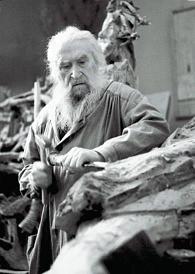<Back to Index>
- Sculptor Sergey Timofeyevich Konenkov, 1874
PAGE SPONSOR

Sergey Timofeyevich Konenkov (alt. spelling Sergei Konyonkov) (Russian: Сергей Тимофеевич Конёнков; July 10, 1874 – December 9, 1971) was a famous Russian and Soviet sculptor. He was often called "the Russian Rodin".
Konenkov was born in a peasant family, in a village of Karakovichi in Smolensk province. Sergey studied at the Moscow School of Painting, Sculpture and Architecture, graduating in 1897, and at the St. Petersburg Academy of Arts. His diploma work at the Academy - a huge clay statue of Samson tearing the chains - broke most existing laws of academic art and put him at odds with his teachers, who apparently destroyed the work with hammers.
He traveled to Italy, France, Egypt, Greece and Germany.
During the Russian revolution of 1905 Konenkov was with the workers on the barricades, soon after creating portraits of the heroes of the rebellion in Moscow. Konenkov later supported the Russian Revolution of 1917.
In 1922 Konenkov married Margarita Ivanovna Vorontsova, and in 1923 they traveled to the USA to take part in an exhibition of Russian and Soviet art. The trip was supposed to last for a few months, but Konenkov stayed in the States for 22 years, living and working in New York.
In 1928 – 1929 the sculptor visited Italy to meet and work on a portrait of the Soviet writer Maksim Gorky. He had a personal exhibition in Rome.
During the American period, Konenkov created a large body of work focusing on Bible themes, the Apocalypsis. He produced works depicting Jesus Christ, the Christian prophets and apostles.
In 1935 he was commissioned by Princeton University to do a sculpture of Albert Einstein.
It is said that Einstein was interested in the work of the Russian
sculptor, but was more focused on his wife, Margarita Konenkova.
Einstein and Margarita, who also was acquainted with Robert Oppenheimer, allegedly had a love affair, judging by the "nine of the great
scientist's apparently genuine love letters, written in 1945 and 1946". There have been allegations that Margarita was working in those years for the
Soviet Government, but no concrete evidence has been provided to
support the theory.
Under direct orders from Joseph Stalin in 1945, a ship was sent to New York to bring Konenkov back to the USSR. The sculptor was given a large studio on Gorky street in the center of Moscow. He "had found favor enough with the regime to be asked to design a plaque commemorating the first anniversary of the October Revolution on the Senate Tower of the Kremlin".
Konenkov created sculptures of Aleksandr Pushkin, Anton Chekhov, Leo Tolstoy, Fyodor Dostoyevsky, Ivan Turgenev, Vladimir Mayakovsky, Konstantin Tsiolkovsky, Vasily Surikov, Johann Bach, Paganini, to name a few. He also made wood carved crosses and other pieces for the Marfo - Mariinsky Convent in Moscow.
Konenkov received numerous Soviet awards, including the golden star of the Hero of Socialist Labor, the order of Lenin and the title Peoples artist of the USSR.
He is buried in Moscow’s Novodevichy Convent.